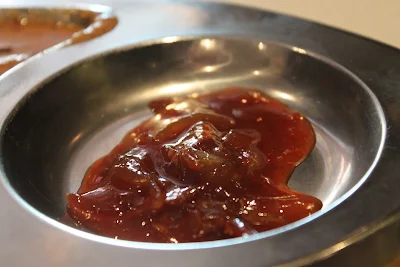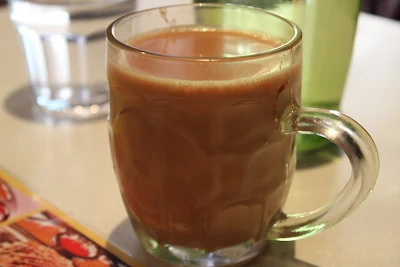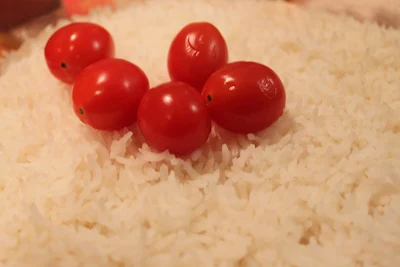There are now more than a few cafes and restaurants providing the roti canai and murtabak in Sydney CBD. In India and South-east Asia, they first emerged as handy and viable backpacker food to the throngs of Western visitors from the seventies to the nineties. They are delicate, airy and appetising to fill up any one's hunger pangs. The roti can be eaten plain, or dipped in light vegetarian, dhall bean or meat curry gravy. Above, the serving at the Mamak Village cafe along Glebe Point Road near the junction with Broadway.
I was especially taken with the anchovy-based condiment above at Mamak Village.
My accompanying mates who live nearby in this precinct have so much choice and variety of food that they may not have been as enthusiastic as me for this mamak cuisine.
Above, a balcony with a view upstairs at Mamak Village in Glebe, reminding me of a comparable scenery from the Lee & Me Cafe along Crown Street in Wollongong CBD. Below, an authentic tasting teh tarik, to accompany the meal.
Below, the lobak spring rolls, in a unique version originating from my home island of Penang in Malaysia. I found the accompanying condiment different - instead of just a hot and sweet chili sauce found in Penang coffee shops, Mamak Village prepared their own mix. The lobak was a bit over the top in saltiness that day.
Malacca Straits Restaurant (above) , inside the Quadrant Building at 66 Mountain Street, Broadway, is best accessed from George Street, opposite the branch of the Notre Dame University. We saw a neighbouring table order what looked like succulent chicken-on-the-skin for Hainan chicken rice and a serving of the murtabak. They also have available the Penang kapitan curry, Thai crying tiger (marinated BBQ beef fillet served with hot chili sauce) and the curry fishhead (AUD 20 per piece). As our visit was only meant as for an arvo tea time snack, we chose their stated signature dish - Kuala Lumpur styled curry laksa. (below)
To an ex-Penangite like me, the soup was tasty but smacked of salted fish flavours, but it did have a strong and appreciated spicy and herbal sensation as one took it with the chicken slices, deep fried tofu squares and sliced vegetables.
To round up the evening in Sydney CBD, but this time beyond Broadway, another set of mates joined me at World Square's Malaysian Indian outlet, situated along a passageway that shouts out "Eat Drink Enjoy Share" if you are coming from inside the open air plaza.
Otherwise, appraoch this passageway from Liverpool Street, with an entrance along the road between the Meriton Serviced Apartments and Zozo. To our disappointment, the resident Nepali fresh roti maker had alreday retired by the time we arrived, and we had to make do with two curry choices served with steamed white rice - mine was tamarind flavoured hard boiled egg curry (unusual) and red chicken curry. (above). Their rotis are worth a try - and you can watch them make it right in front of you. The Mirchis Indian outlet across the passageway does not make such fresh roti pancakes.
After all that spicy food on this Malaysian food trail, I would recommend a hearty fresh mixed fruit juice pack from Three Beans Cafe at the Broadway Shopping Centre. (above) This place epitomises the benefits of location, location, location. It is at the confluence of different market groups with regular purchasing patronage - university students, CBD residents, the twenty to thrity something yuppies and frequenters from outside exploring nearby Chinatown, Surry Hills and Newtown.






































